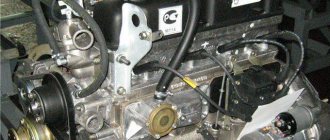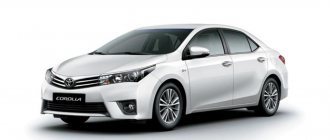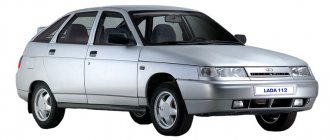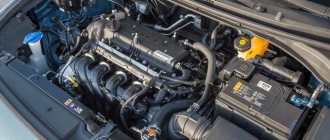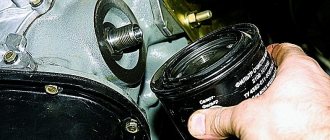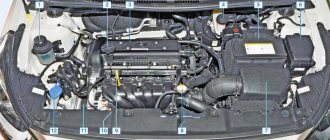Oil specifications for Hyundai Solaris with an engine capacity of 1. or 1.6 liters
The engines of Solaris cars that come off the assembly line are filled with lubricant with the following specification - 5W-20/SL/GF3 . Due to its low degree of viscosity, it allows the vehicle to be operated in climatic conditions with significant temperature changes. Additives added to the lubricant make it possible to maintain the engine in the required cleanliness throughout its entire service life and protect its parts from wear. However, after some time, these additives lose their properties, so changing the oil on Hyundai Solaris is a necessary and vital process.
The manufacturer himself recommends when replacing using Shell Helix Ultra 5W-30 , which has all the necessary qualities. The vehicle owner must make his choice not only based on the manufacturer’s recommendations, but also based on the conditions in which the operation will be carried out.
So, for example, if these are areas with a temperate climate , an oil with an index of 10W-30 , which has an operating temperature range from -15˚ C to +50˚ C,
As for how much oil is needed for replacement, you can find out from the technical documentation for the car.
A four-liter canister will be quite enough, since an engine with a volume of 1400 cc will require 3.3 liters, and with a volume of 1600 cc . cm - 3.7 liters.
Thanks to additives, motor fluid is endowed with the necessary and very important characteristics:
- cleaning - protecting the internal space of the engine from the appearance of dirt deposits on the surface of parts and the occurrence of negative compounds. Thanks to this property, your car’s engine will always be in proper cleanliness, which contributes to a long service life;
- lubricating - due to which an oil film is formed on the surface of parts, reducing the friction force of all moving components. The wear of parts is significantly reduced, which also affects the service life of the power unit;
- protective - preventing the occurrence of oxidation processes and the occurrence of corrosion;
- cooling - excess temperature is removed from the surface of parts. As a result, all engine elements are reliably protected from overheating.
This is interesting: How to set a temperature trigger on a tomahawk
How to choose products?
The choice of lubricants is influenced by the characteristics of the car engine and the temperature conditions of the region, so the oil should be different for different times of the year. The lubricant is classified by API and viscosity by SAE. As a rule, replacement must be carried out after every 15,000 km, but if we take into account the unfavorable external environment, then the replacement period is reduced by half, that is, every 7,000-8,000 km.
Oil classification according to SAE, API
According to this rating system, oil is classified according to viscosity and temperature data and is divided (by additives) into 9 types. Of these, only 3 are considered demi-season, that is, for spring, summer and autumn, and 6 are winter. It is the latter that are designated by the English letter W, to which certain numbers are assigned indicating the degree of viscosity of the material.
The higher the number, the correspondingly higher the properties. But there are also additives that have universal data that are suitable for any time of year and different temperatures. Since engines come in different types, the oil for them (based on temperature properties) is selected differently. This is due to the following parameters:
- starter power;
- shaft rotation speed value;
- hydraulic resistance;
- quality of the fuel being poured;
- general condition of the engine.
API classification divides oil into categories:
- Indicated by the letter “S”, which is intended for a gasoline engine.
- Indicated by the letter “C”, used only for engines running on diesel fuel.
Both categories are divided into classes according to the level of quality and compliance with the engine. When choosing an oil, you need to take into account its composition. For example, synthetic types are more liquid. This has a beneficial effect on the penetration of material through all connections.
Some drivers, having discovered a leak in the oil seal, blame it on the lubricator, although in fact this is not the case. You just need to replace the working surface of the cuff. It must be remembered that under no circumstances should synthetic oil be poured into outdated designs, because the stuffing box packing is not designed for this.
The more expensive the better
As for the question of price and quality, it is impossible to answer it unequivocally. Bench and field tests show little difference between expensive oils and economy class products. This is due to the fact that similar base oils are taken as a basis, and differences in characteristics are obtained due to the percentage of one or another group of additives.
Often, liquids from a world-famous manufacturer will cost significantly more than little-known analogues. However, the percentage of counterfeit products from well-known brands is quite high, but few people will counterfeit unfamiliar brands. To avoid encountering low-quality materials, you should purchase lubricants only in specialized stores representing a particular company.
Based on the recommendations of the manufacturer, it is quite possible to fill the Hyundai Solaris with budget category lubricants.
This includes products from the following domestic companies:
- Lukoil;
- Rosneft;
- TNK.
If you wish, you can also purchase original oil, which will definitely be the best option.
If you cannot find it, you will be required to purchase a product with the most suitable characteristics.
What oil does the manufacturer recommend?
The manufacturer recommends filling the Hyundai Solaris engine with lubricants with a viscosity index of 5W-20 or 5W-30.
In addition, these materials must meet the following requirements:
- according to API - SM approval;
- according to ILSAC - not lower than GF-4. This category has energy-saving properties and high resistance to oxidative processes. In addition, oils that meet this standard have good cleaning properties and are compatible with systems equipped with catalysts.
More on the topic: Hyundai Solaris won’t start The starter turns, but does not engage
The most preferable is the branded Shell Helix Ultra 5W-30 motor oil, which has a fully synthetic base obtained from natural gas by synthesis.
The advantages of this product are quite obvious:
- the foundation is produced using PurePlus technology;
- low viscosity allows significant fuel savings;
- promotes easy engine starting in the cold season;
- meets the required environmental standards;
- prevents the formation of soot.
As an alternative, products from other manufacturers that meet the specified standards can be used:
- Liqui Moly Special Tec 0W-20;
- Mobil 15W-30;
- Hyundai Premium LF Gasoline 5W-20;
- Zic X7 5W-40;
- Zic X9 5W-30;
- Castrol Magnatec 5W-30 and some others.
2272-4-7-a-03
We check the condition of the sealing aluminum washer of the plug.
If the washer is severely deformed or worn, replace it with a new one.
After wiping the plug, screw it on and tighten it. We remove oil drips from the engine sump cover. We place the container under the oil filter and unscrew it, rotating it counterclockwise.
When is an oil change required?
According to the regulations for changing the oil in the Hyundai Solaris engine, it is recommended to update the engine lubricant every 10-15 kilometers of active mileage - that is, once a year. However, in practice, replacing the technical fluid in the vehicle system is required more often.
The reasons for the need for accelerated replacement are the following circumstances and nuances:
- Low quality or decreased level of motor lubricant used;
- Features of seasonal temperatures and landscape of the area;
- The car owner's passion for extreme driving;
- Emergency condition of the constituent elements of the vehicle propulsion system.
Signs of obsolescence or unsuitability of motor lubricant in a Hyundai Solaris are listed below:
- The liquid begins to smell of soot;
- The lubrication becomes uneven; upon closer inspection, lumps of dirt and metal shavings are recognized;
- The original color of the oil changes to a dirtier and darker one;
- The technical substance becomes thicker and fattier, and the original viscosity of the oil is lost.
In turn, if you need to find out the exact level of engine lubrication, check the oil using a dipstick. This meter for the amount of technical substance is removed from the control hole of the Hyundai Solaris engine, wiped with a napkin or rag and again immersed in hot oil. After this, the dipstick is removed again, and the car enthusiast can study its performance. If the indicator is equal to or less than the permissible minimum, therefore, the motor lubricant is not enough and it is necessary to urgently replenish its missing percentage.
It is important to consider that the reason for the need for an urgent oil change in a Hyundai Solaris engine may be a leak resulting from a traffic accident or a system breakdown due to a high degree of wear of individual parts. In these cases, not only updating the engine lubrication is required, but also a complete repair of the vehicle. If the breakdowns are extensive, the car owner should contact a Hyundai Vehicle Service Station.
This is interesting: How to reset a wrench on a Peugeot 308
Hyundai Solaris 1.6 - what engine oil to use
Changing the oil in a Hyundai Solaris engine is a rather important task, which begins with choosing a high-quality lubricant.
One of the criteria that you need to focus on is the viscosity of the product.
For a 1.6 liter Hyundai Solaris engine, a lubricant with an SAE 5W-30 rating would be preferable. This parameter is designed for American, Japanese and Korean-made cars, and as for the Hyundai Solaris, it is quite suitable for engines with any technical condition.
As an alternative, you can use motor fluids with SAE 5W-40 and SAE 10W-40 ratings.
When choosing a lubricant, try to avoid products with low viscosity, which negatively affects the moving elements of the power unit. This applies to a greater extent to engines with a significant percentage of output. In addition, oils with low viscosity have a high level of volatility and lose their performance properties much faster than high-viscosity ones. In this regard, they will have to not only be changed more often, but also constantly added to the car engine.
As for liquids with a high viscosity index, here you can choose products with the following parameters:
- 5W-50;
- 10W-50;
- 20W-50;
- 10W-60;
- 15W-60.
Also, when choosing a lubricant, you should decide on the type of product, which can be mineral, semi-synthetic or fully synthetic. Having the same properties and specifications, they will differ from each other in thickness.
More on the topic: How to choose wheels for Hyundai Solaris
A thicker lubricant is preferable for hot regions, where it will do its job perfectly, and a lubricant with high fluidity is preferable for colder regions.
For modern 1.6 liter Hyundai Solaris engines, synthetic oils that do not lose their characteristics throughout their service life will be preferable.
Before changing the lubricant, every motorist asks questions about “how often to change the lubricant” and “what kind of oil to fill.”
It is best for Hyundai Solaris owners to pay attention to the official recommendations, which advise carrying out maintenance, including changing the lubricant, at least after every 15,000 km.
It is also worth thinking about what kind of oil to fill in the Hyundai Solaris. Today there is a large selection of different types of motor lubricant from a large number of manufacturers. It is best to choose any option from foreign analogues, since their products have the fewest counterfeits.
Domestic manufacturers are not doing so well now, as evidenced by the fact that 90% of all counterfeits have their names and brands.
There is an SAE system by which you can make a choice both for this car and for the Hyundai Getz, as well as other models of the South Korean company.
There are basically nine oil options, 6 of which are designed for use in the winter season. You can distinguish them from the summer version by the letter “W” from the word winter (winter in English). The number after this letter indicates the viscosity level of the liquid. For different temperature modes, a different option is selected, since in some cases there is no need for the driver to overpay for improved characteristics that he does not need.
There are also off-season options for engine lubricant. Before choosing which oil to pour into the engine, you should pay attention to off-season modifications of the lubricant, which can be distinguished from others by two numbers after the letter. These numbers indicate the viscosity range. This lubricant is well suited for temperate climates with small temperature changes.
It is also worth noting that for both this model and the Hyundai Solaris, the required temperature ranges may vary depending on the type of engine used.
The following characteristics also influence the selection of motor lubricant:
- the quality of the fuel used, which directly affects the performance of the car;
- starter rated power;
- what condition the motor is in;
- minimum values of shaft rotation speed.
Taking these parameters into account, you can select oil for both the above-mentioned car model and the Hyundai Getz.
Level check
During operation, each car owner is required to check the oil level in the engine of the Korean Hyundai Solaris car. The procedure is not the most complicated, but it allows you to control the level and condition of engine lubrication. This is how they react promptly to fluid wear or increased consumption. If the amount of lubricant has decreased, but it is still suitable for use, you simply need to add the missing amount.
To check the level, follow the instructions:
- If the car has been warmed up and you have just parked, wait about 10 minutes so that all the oil from the system drains into the crankcase.
- To check, use as level a surface as possible. If the level is higher than normal, this is also bad, since the likelihood of fluid leakage and increased consumption increases.
- The dipstick is located in the front part of the engine compartment, not far from the oil filler plug.
- Remove the dipstick, wipe it dry with a clean cloth and return it to its place. Remove the dipstick again. A film of oil will appear on it between o and “Max”.
- If the level approaches the minimum value, the lubricant will need to be added.
- Topping up is done by unscrewing the filler plug. Using a funnel, fresh liquid is poured into it.
- Allow the oil to drain into the crankcase. To do this, wait a few minutes. Then repeat the manipulations with the probe.
- All smudges must be removed with a rag so that no oil stains remain anywhere on the engine and its components. Otherwise, with strong heating, there is a risk of fire, which will lead to serious consequences for the entire car.
If the oil has been filled for a long time, then you will need to check its condition. Drop it onto a white napkin or cloth. You can drop fresh oil of a similar brand and similar characteristics nearby. If the old grease is dark, cloudy, has traces of debris or particles of metal shavings, proceed with replacement.
Checking the oil level
If the oil level in a new car does not require regular checking, then over time this procedure will need to be carried out more often. There are cases when the engine begins to require adding fluid of 0.5 liters or more after a mileage of only 20,000 kilometers. If such a fact occurs and the car is under warranty, you must contact official dealers to find out the reason.
The oil level is checked in the traditional way - using an oil dipstick with the engine turned off after 20-30 minutes after stopping it. When removing the measuring element, do not try to turn it upside down. Take the measurement with the probe in a vertical position.
2272-4-7-a-06
Apply engine oil to the filter O-ring.
We wrap the oil filter by hand until the sealing ring touches the oil filter bracket. Then turn the filter another 3/4 turn to seal the connection. Pour 3.3 liters of oil into the engine through the oil filler neck. Screw the oil filler cap clockwise. We start the engine for 1–2 minutes. We make sure that the indicator of insufficient (emergency) oil pressure in the engine in the instrument cluster has gone out and there are no oil leaks from under the plug and filter. If necessary, tighten the drain plug and filter. We stop the engine, after a few minutes (so that the oil has time to drain into the oil pan), check the oil level and bring it to normal.
Changing the engine oil and oil filter Hyundai Solaris
Replacement frequency
It is recommended to change the engine oil in the Hyundai Solaris 1.6 after 15 thousand kilometers. Unfortunately, these official data are not always relevant for the difficult Russian climate. So, if we take into account various road and climatic nuances, the replacement schedule can be reduced to 10 thousand km.
The most popular articles on the site:
- How often should you change engine oil?
- Oil 5w30 and 5w40 what is the difference
- What oil to pour into the engine in winter and summer
- How long does it take to change the automatic transmission oil?
Selection of filter and analogues
An original oil filter will protect your car’s engine from rapid wear by efficiently removing all kinds of particles and dirt from the engine fluid. Thanks to its qualities, the oil filter is able to make the operating conditions of the power unit as comfortable as possible.
The original filter is Hyundai 26300-35503 , which is not much higher than its analogues. If you couldn’t find a similar filter, you can use the most suitable ones:
- JapanParts FO-599S;
- Parts-Mall PBA-001;
- Mann W8017;
- Nipparts N1310510;
- Patron PF4219;
- filter Nevsky NF1019.
This is not a complete list of third-party filters that you can use when changing your oil.
When to change and what kind of oil to fill in Solaris
The frequency of oil changes is 15,000 km or once a year. Along with the oil, the oil filter must also be replaced.
The engine oil filling volume is 3.3 liters . The new oil must meet API SM and ILSAC GF-4 quality. Viscosity depends on the temperature of the region in which the car is driven:
- from -10 to +50 °C - SAE 20W50;
- from -15 to +50 °C - SAE 15W40;
- from -20 to +50 °C - SAE 10W30;
- from -30 to +50 °C - SAE 5W30.
The catalog number of the original HYUNDAI Premium Gasoline 5W30 GF-4 oil (4 liter canister) is 0510000410 (5W20 - 5100004510001).
The catalog number of the original HYUNDAI oil filter is 2630035503. Analogs: MANN W81180, MAHLE OC205, BOSCH 451103316, SAKURA C1003 and others.
catalog number for the drain bolt gasket is 2151323001.
How not to buy a fake
When purchasing oil that is recommended by the manufacturer, carefully study the packaging and check its quality.
The check could be like this:
- Pour the lubricant into a clear glass and let it sit for several hours. The original will remain homogeneous in composition, but the fake will disintegrate into layers and may “throw out” sediment;
- drop the liquid to be tested onto a white sheet of paper and wait until it is completely absorbed. After that, carefully examine it for various inclusions. It is quite possible for a fake to have them, but not for an original.
And most importantly, purchase lubricants only from official dealers or specialized stores that provide a guarantee for their products.
Level control and required volume
Briefly about how to check the level and how many liters of oil should be poured into the Solaris power unit. The process of checking the fluid volume is performed on a cold engine. After the trip, wait about 20-30 minutes until the engine cools down. During this time, the lubricant will flow through the lines into the engine, but will not have time to completely go into the crankcase. To diagnose, open the hood and find the dipstick; it is located on the cylinder block in a special hole. Remove the meter and wipe it with a cloth. Reinstall the dipstick and pull it out again. The consumable level should ideally be between two marks - MIN and MAX. How much lubricant to pour into the engine depends on the volume of the power unit. Check the service manual for more details. On average, the unit is filled with liquid in a volume of 1.6 to 3.7 liters.
Possible causes of oil consumption
Sometimes the reasons for excess lubricant consumption are due to mechanical engine malfunctions. The car owner will face expensive repairs if the problems are related to a malfunction of the return lines, large play in the bearing device on the supercharger, a breakdown of the high-pressure fuel pump, contamination of the intake air flow, etc.
The channel “Oil Change and Other Types of Minor Repairs” provided a video that describes in detail the process of changing the lubricant in Solaris.
The main reasons for overspending:
- Using poor quality lubricant. Over time, consumables lose their properties and cannot perform the tasks assigned to them. Lubrication of internal engine components becomes less effective. As a result, part of the liquid volume is lost to soot and deposited as sediment on its internal components.
- The appearance of leaks. Oil can escape through oil seals or sealing elements. Sometimes the cause is a worn o-ring on the drain plug. The problem may be cracks in the engine.
- Broken cylinder head gasket. With such a malfunction, the oil will go into the cooling system and mix with antifreeze, and the coolant may enter the engine fluid.
Professional automatic transmission oil change for Hyundai Solaris: price, affordable quality and guarantee
Updating the gearbox (gearbox) lubricant is a slightly more complex process. And therefore more expensive. To do this, you have to disassemble this unit, and in some cases, especially when it comes to an automatic transmission, you also have to wash almost all of its components in a special solution. But it is necessary to do this from time to time, since the product gradually exhausts its resource and loses its properties. And in automatic transmissions, oil performs not only lubricating, but also a number of other functions.
There are lubricants specifically designed for gearboxes. Moreover, not all are suitable for a machine gun. Without going into details, we’ll just say that you should choose a product for pouring into a gearbox based on two parameters:
- manufacturer (the more famous the brand, the higher the likelihood that you have a truly high-quality product);
- color of the product. Only red and yellow oils are acceptable for the machine. Green is exclusively for manual boxes.
The question of the frequency of this procedure still does not have a clear answer. Of course, the more often the better. Hardly anyone can argue with this. But what is the optimal mileage of a car on one transmission oil? Most experts agree that 50 thousand km. for automatic transmission - this is the optimal distance.
However, if during scheduled maintenance the technician offers you, in addition to all other procedures, an oil change in the Solaris automatic transmission, the price of which you can check immediately on the spot, you should not refuse - as part of a comprehensive Solaris service, the price for changing the oil in the box will be significantly lower .
Changing the lubricant yourself
You can change consumables yourself; you don’t have to go to a service station to do this.
Required Tools
What you will need to change the fluid:
- set of wrenches and sockets;
- an oil filter remover or screwdriver;
- new oil;
- new filter device;
- gasket for the drain plug;
- an old bucket or basin into which the “working off” will be drained;
- clean rags.
User Roman Smirnov showed in his video how consumables are replaced in the Solaris lubrication system.
Stages of work
How to change the lubricant in the Solaris internal combustion engine with your own hands:
- Prepare your car in advance. Warm up the engine to a temperature of about 60-70 degrees and take a test ride. This is necessary so that the lubricant becomes more viscous and disperses through all channels of the lubrication system.
- Stop the engine and open the hood. In the engine compartment on the cylinder head you will see a filler neck; you need to unscrew its cap. There is no need to add oil. The cap is unscrewed in order to relieve pressure in the system and speed up the draining procedure.
- Reach under the bottom of the car and find the drain hole on the cylinder block. If the car is equipped with oil pan protection, it must be removed by unscrewing all the bolts. Place a basin or bucket under the drain hole, then unscrew the plug with a wrench.
- The process of draining the waste substance will begin. Wait until the lubricant is completely out of the system, then tighten the plug.
- Remove the oil filter. Try unscrewing it counterclockwise with your own hands. If it doesn’t work, use a dismantling tool; such a key can be purchased at any car store. If you don’t have a key, you can pierce the oil filter housing with a screwdriver and then use it as a lever to unscrew the device. Please note that you need to pierce the housing as close to the bottom of the filter as possible, away from the threads, so as not to damage the internal combustion engine components.
- Pour new oil into the system. Take a new filter and add about 100-150 ml of liquid to it. The sealing rubber located next to the thread must be treated with a layer of lubricant, this will prevent the filter device from sticking to the seat. Install the filter and screw it on without much effort.
- Reinstall the engine protection and check the lubricant level in the system. According to the dipstick, the volume of the substance should be between the MIN and MAX marks.
- Start the engine and perform a test drive. After this, check the lubricant level again.
Do-it-yourself oil change in a Hyundai Solaris engine? - sequencing.
1. Drive the car into the pit. Turn off the engine and wait until it cools down a little. It should be warm, but not scalding.
2. Using a 17mm spanner, loosen the clamp on the drain plug. Use a rag to clean it from dirt.
3. Place a previously prepared container under the drain hole, manually completely unscrew the plug and carefully (the oil is very hot!) drain the used oil. Try to wait until it drains completely. This is at least 10 minutes!
4. You can occupy this period of time with a useful activity - visual diagnostics of the aluminum sealing washer of the drain plug (the latter must first be thoroughly cleaned). If you find significant deformation or wear on it, this part will have to be replaced.
5. If everything is in order, return the plug to its rightful place and tighten thoroughly.
6. Wipe the crankcase cover, removing any oil stains.
7. Move the already used container under the oil filter and unscrew it manually or using a puller, rotating it to the left.
8. Remove the oil filter.
9. Thoroughly clean the seat from dirt, dust and, of course, oil.
10. Apply a little engine oil (about 1/3 of its volume) to the O-ring of the pre-purchased filter and hand-tighten it until the O-ring comes into contact with the bracket.
11. To seal the connection, rotate the installed oil filter another ¾ turn.
12. Fill the engine with oil through the oil filler neck and close the latter with a cap.
13. Turn on the ignition and let the car idle for a couple of minutes. At the same time, make sure that a couple of seconds after starting the engine, the emergency (insufficient) oil pressure indicator goes out.
14. Inspect the oil filter and drain plug for leaks. If necessary, tighten the filter and plug (just turn off the car first!).
15. Turn off the ignition and use the dipstick to check the oil level in the tank. Top it up to normal.
At this point, you can forget the question of how to change the oil in the engine for the next 7-8 thousand kilometers. The manual says 15 thousand km, but make no mistake, this is under ideal conditions
Step-by-step instruction
To carry out an oil change yourself, you need to follow the following instructions:
- First you need to open the hood of the car and remove the cap from the oil reservoir;
- Next, the used lubricant is drained. To do this, place a reservoir with a funnel under the drain plug, remove the lid and wait for the final drainage of the liquid. To speed up the process, warm up the engine before replacing;
- The plug is closed, the engine protection is put back;
- The filter is being replaced. In some cases it will be necessary to use a special puller. Before installing a new one, it is necessary to fill it with fresh oil in a small amount;
- Oil is poured into the reservoir. It is necessary to ensure that the liquid does not exceed the maximum mark in the tank.
Consequences of untimely replacement
Changing the oil in a Hyundai Solaris engine with your own hands is a fairly routine procedure, so some car enthusiasts neglect it. However, such a frivolous attitude towards the condition of vehicle systems can lead to serious consequences, in particular:
- To wear and irreversible damage to individual engine parts. If the lubricant is not viscous enough or too thick, it will not be able to neutralize soot and oxidation products. This creates a favorable environment for the development of corrosion processes;
- To rotate the connecting rod bearings. Increased friction and overheating of these parts leads to increased pressure on them;
- Failure of turbocharger elements.
All these possible car breakdowns require subsequent serious repairs, and therefore significant financial expenses. To avoid this unpleasant phenomenon, you should promptly update the engine lubricant in the Hyundai Solaris.
Oil change Solaris 1.6
- 128 0 64k
- 34 4 27k
Calculator for calculating engine oil consumption rates
Calculation of engine oil consumption.
Online calculator of oil burn rate per 100 liters and 1000 km Oil change for Hyundai Solaris (4th generation Accent, 2013) is included in the list of vehicle routine maintenance procedures. Changing the oil and oil filter yourself is very simple. This instruction with photo will show how to change the oil in the 1.6 Gamma GDI Hyundai Solaris/Accent engine.
To change the engine oil you will need : a ratchet with a 17mm socket, an oil filter puller (possibly), a jack with stops or a car ramp, a rag, a funnel, an empty container for used oil, a new drain bolt gasket, a new oil filter and a 4mm canister of fresh oil liters

